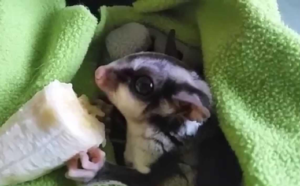Sugar gliders are adorable, energetic marsupials that have captured the hearts of pet enthusiasts worldwide. As responsible pet owners, ensuring the safety and health of their diet is essential. One common question is: Can sugar gliders eat bananas?
The answer is yes, sugar gliders can eat bananas, but there are important considerations to keep in mind. In this article, we’ll explore whether bananas are safe for sugar gliders, their nutritional benefits, how to serve them, and other essential feeding tips to keep your pet healthy and happy.
Are Bananas Safe for Sugar Gliders?

Yes, bananas are safe for sugar gliders to eat in moderation. Bananas are a natural source of sugar, carbohydrates, and essential nutrients. However, due to their high sugar content, bananas should be fed as a treat rather than a staple food. Sugar gliders thrive on a balanced diet that includes fresh fruits, vegetables, protein, and calcium-rich foods.
You may love this article: Can Rabbits Eat Watermelon?
Nutritional Benefits of Bananas for Sugar Gliders
Bananas contain several beneficial nutrients for sugar gliders, including:
- Vitamin B6: Supports brain health and aids in protein metabolism.
- Vitamin C: Boosts the immune system and helps fight off illnesses.
- Potassium: Helps maintain proper muscle and nerve function.
- Fiber: Promotes a healthy digestive system.
- Antioxidants: Protect cells from damage and improve overall health.
While these nutrients can benefit sugar gliders, it’s important to balance bananas with other foods to meet their overall dietary needs.
How to Feed Bananas to Sugar Gliders

Here are some tips to safely incorporate bananas into your sugar glider’s diet:
Serve in Small Portions
Bananas should only be offered in small slices or bite-sized pieces. A portion no larger than the size of your sugar glider’s paw is ideal. Overfeeding bananas can lead to excessive sugar intake, which may contribute to obesity or other health issues.
Use Fresh Bananas
Always choose ripe, fresh bananas. Avoid feeding unripe or overly ripe bananas, as they may upset your sugar glider’s stomach.
Introduce Gradually
If your sugar glider has never had bananas before, introduce them gradually. Monitor for any adverse reactions, such as changes in stool or unusual behavior.
Wash Thoroughly
While bananas have a peel that protects the fruit, it’s still a good practice to wash them before slicing to remove any potential pesticide residue.
Avoid Artificial Banana Products
Never feed sugar gliders artificial banana-flavored snacks, banana chips, or dried bananas with added sugar. These are not healthy for your pet and can lead to health issues over time.
Risks of Feeding Bananas to Sugar Gliders
While bananas can be a healthy treat, there are some risks to be aware of:
- High Sugar Content: Too much sugar can lead to weight gain, dental problems, and even diabetes in sugar gliders.
- Calcium-Phosphorus Ratio: Bananas have a higher phosphorus content compared to calcium. This imbalance can interfere with calcium absorption, potentially leading to metabolic bone disease (MBD) if bananas are overfed.
- Choking Hazard: Large chunks of banana can be difficult for sugar gliders to eat. Always cut the fruit into small, manageable pieces.
To counteract the calcium-phosphorus imbalance, pair bananas with calcium-rich foods, such as leafy greens or yogurt.
Alternative Fruits for Sugar Gliders
In addition to bananas, sugar gliders can enjoy a variety of fruits to keep their diet diverse and nutritious. Here are some safe options:
- Apples (seedless)
- Blueberries
- Mangoes
- Papayas
- Watermelon
- Pears
Each fruit offers unique nutrients that contribute to your sugar glider’s overall health. Rotating fruits ensures they receive a variety of vitamins and minerals.
Feeding Bananas as Part of a Balanced Diet
Sugar gliders require a diet that includes:
- Fruits and Vegetables: Fresh produce should make up about 25% of their diet. Bananas can be included as part of this category but should not dominate it.
- Protein Sources: Provide protein through boiled eggs, cooked chicken, or specially formulated sugar glider pellets.
- Calcium-Rich Foods: Prevent calcium deficiencies by offering foods with a high calcium-to-phosphorus ratio, such as broccoli or kale.
- Treats in Moderation: Use bananas and other sugary fruits sparingly as occasional treats.
When to Avoid Bananas
Although bananas are generally safe, avoid feeding them in the following situations:
- If Your Sugar Glider Is Overweight: Bananas can contribute to weight gain due to their sugar content.
- If Digestive Issues Occur: Diarrhea or stomach upset after eating bananas may indicate that your sugar glider is sensitive to them. Discontinue feeding and consult your vet.
- If You Suspect Allergies: While rare, some sugar gliders may have allergies to certain fruits. Watch for symptoms such as swelling, itching, or changes in behavior.
Final Thoughts
Bananas are a safe and nutritious treat for sugar gliders when fed in moderation. They provide essential vitamins and minerals that contribute to your pet’s overall health. However, it’s vital to maintain a balanced diet and avoid overfeeding sugary fruits.
By offering bananas alongside other healthy foods, you can ensure your sugar glider remains happy, healthy, and full of energy. Always observe your pet’s reactions to new foods and consult a veterinarian if you have any concerns about their diet.
